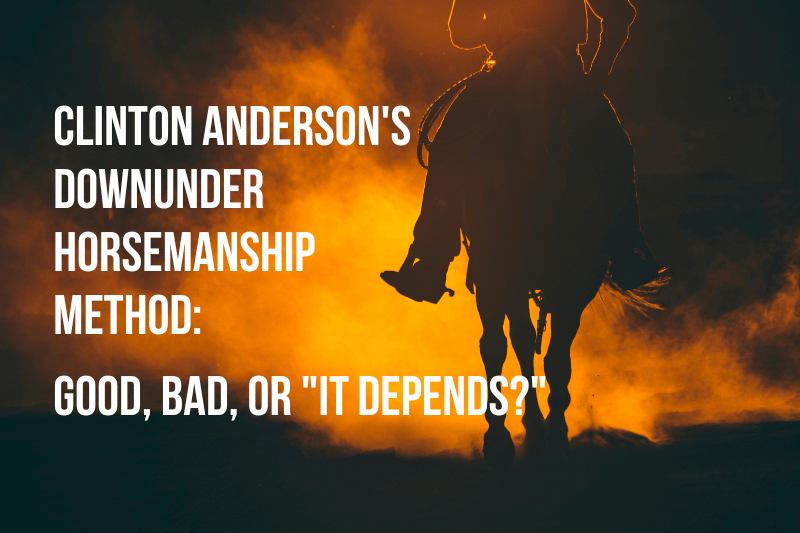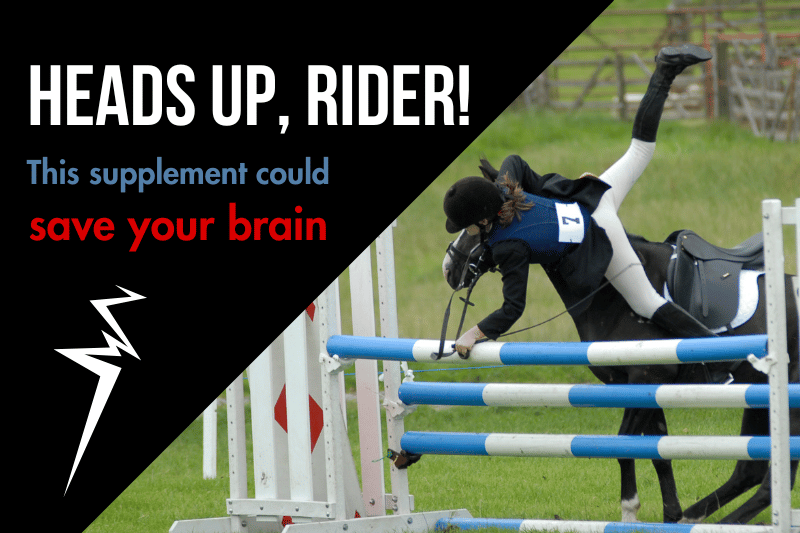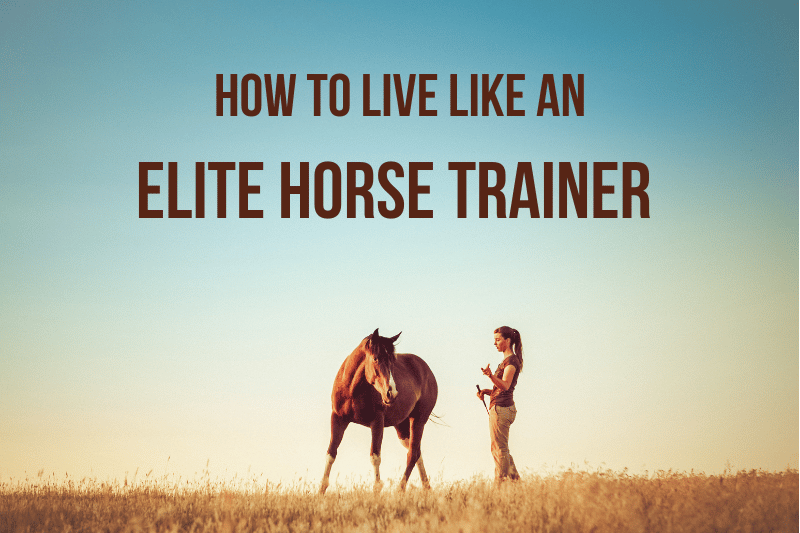Of all the products I’ve reviewed, the Downunder Horsemanship Method may be the most controversial. The horse world loves to love Clinton Anderson, and it loves to hate him more.
I get it. His personality isn’t for everyone. It isn’t even for me, most of the time. But this post isn’t about his snarky comments or crass humor. It’s about his training method. Is it good? Bad? It depends?
What is the Clinton Anderson Downunder Horsemanship Method?
The Downunder Horsemanship Method is a horse training framework taught by Clinton Anderson. Anderson recommends taking every horse, whether it’s being started for the first time or ready to advance, through sets of exercises in a specific order. He also promotes his Method for dealing with problem behaviors, indirectly, by addressing the underlying mental/emotional state (typically either fear or lack of respect). The goal is to produce solid, reliable horses prepared for safe handling in diverse circumstances.
Anderson’s core training series was introduced on video beginning with the Fundamentals in 2010, then expanded to Intermediate and Advanced. He now has dozens of videos available through an online subscription service he calls, with unabashed Aussie branding, the No Worries Club. In the arms of social media, the Method’s ethos encourages unquestioning adherence by its thousands of acolytes
The hallmark of the Anderson’s videos, early on, was his methodical approach to teaching people to train horses. The Fundamentals, Intermediate, and Advanced series offer step-by-step demonstrations of specific groundwork and ridden exercises. These exercises are to be mastered in succession, with each concept building upon the next.
In the videos, Anderson does an extraordinary job of demonstrating the goal with a finished horse, then talking viewers through his process of teaching a new horse each exercise for the first time. He follows each session with trouble-shooting segments that address common horse and handler errors.
My Experience with the Clinton Anderson Downunder Horsemanship Method
I’ve had a couple horses come to me with Method training, including my Arabian gelding. He can be a lot of horse, prone to uncontained energy. Clear boundaries and consistent reinforcement keep him soft and listening. When I took him on, I had some familiarity with the Method, but I decided to learn it properly in order to carry on the good work of his prior owner.
That was a smart decision. Partial knowledge of the Method is considerably less useful than a thorough understanding of the system as a whole. For me, it was worth the money and time to study the videos and implement the sequential lessons regularly.
This proved especially helpful when I decided to buy an Arab mare who was completely unstarted. I could practice the exercises on my gelding, who already knew them, before teaching them to the mare. She, in turn, blossomed over a season of Method training.
I subsequently took on a rescue horse with a reputation for violent bucking and restarted him with the Method. We’re 8 months in and he hasn’t tried to get me off yet.
The Downside of Downunder Horsemanship
There’s always a but, right?
It appears to me that most people ~ including both fangirls and haters ~ don’t take the time (and it is a lot of time) to learn the Method properly. Most also don’t pay for access to the original video series. Instead, they want free, quick fixes and therefore resort to Anderson’s videos on YouTube and TV.
It’s those quick fixes that take Anderson sideways, in my opinion. YouTube drama demands a very problematic horse ~ an aggressive mare that charges her handler, a gelding that won’t get within 30 feet of the trailer, an explosive bucker ~ and flashy, high-action “training.”
Good horse training is like watching paint dry, most of the time. That’s what you get in the original videos: solid examples of Anderson patiently introducing concepts to a green horse.
But the YouTube version? There’s a lot of bit yanking and sweat flying and “my way or the highway.” It hurts to watch.
If those videos had been my first or only exposure to Anderson, I’d have chosen the highway.
The free videos don’t take viewers back to the training stage, where Anderson gives horses time to learn concepts gradually before he expects perfection. This leaves the impression that he always takes a harsh, “do it now or else” approach.
The Method relies on laying a foundation and building upon it in logical steps. Anderson makes this crystal clear in the paid-access, core videos, but it seems few horse owners have the patience to implement it as prescribed. Many want to skip to the good stuff, and they get poor ~ even dangerous ~ results.
Additionally, the nuts-and-bolts approach makes training look easy. As a result, some people lacking experience, feel, and timing take on horses that are too much for them. I don’t care how good a program you’re following: Green and green still make black and blue.
Speaking of black and blue, would friends know how to help if you were injured around the stable or on the trail? My free I.C.E. Pack includes printable placards for barn and trailer, cards for rider and horse, and instructions for friends and family. Get yours now.
Smart Application of the Clinton Anderson Downunder Horsemanship Method
My recommendation? Stay away from the circus.
I could be wrong here, but my read is that Anderson burned out on teaching over the years. His frustration with people not listening to the boring-but-effective advice he’s repeated ad nauseam now boils over as snark and what I call “ego-tude.” I don’t care for how it plays out with either horses or people.
The original Method videos are kinder and more generous. They teach instead of criticize. They emphasize a philosophy of consistency and putting in the work even when you don’t feel like it. “The dream is free,” Anderson says. “The hustle is sold separately.” I can get behind that.
What about the exercises themselves ~ the Method as originally taught before fame and fandom got in the way? My opinion is that they’re excellent tools. But, like any tools (think whips, bits, and spurs) they’re only as good as the handler who wields them.
For me, applying Anderson’s approach felt similar to using a professional fitness program instead of inventing my own. It channeled my existing ability and added new skills. I was already a savvy horseman. The great benefit of the Method, for me, was the organizational structure.
The Method isn’t magic. It can’t be applied by rote and expected to work for just any horse. I had to bring something to the table, especially since I was working with sensitive Arabians instead of Anderson’s preferred Quarter Horses. I needed to read my horses and adjust my application of the Method to suit their needs.
For example, my mare is extremely smart and level-headed. She’s wonderfully curious and sweet. However, she’s also very sensitive and prone to defensiveness when pushed past her comfort zone. She resents micromanagement. If I drill her on a single exercise as long as Anderson does in his videos, she gets frustrated and resorts to obsessive movement.
Horses aren’t one-size-fits-all, and training shouldn’t be, either.
Fortunately, the Method can (and should) be applied differently depending on each horse’s physical, mental, and emotional status. It offers a logical progression that covers more concepts than I would have introduced on my own. The trick is to avoid getting so caught up in the details that I forget to have a conversation with the horse.
I plan to continue using the Downunder Horsemanship Method with my horses, and I recommend it to other riders who can apply it with wisdom rather than attempting an unthinking imitation.
My advice for applying the Method boils down to this:
Keep the clarity, lose the aggressiveness. Keep the progression, lose the discipleship. Keep the consistency, lose the religiosity. Listen to circa-2010 Anderson. Ignore present-day Anderson.
Observe other trainers. Listen to your horse. And always think for yourself.





I audited a multi-day CA clinic about 10 years ago, came back with great stuff I still do today. And an appreciation of why many people (99% of them women?) do not like him, and why I do. He outright mocked women who baby-talk to their horses, call them cutesy pet names, faint at the sight of crops and spurs, got upset if a horse sweated from work, call their horses their best friends or fur babies. He kept stressing they are giant flighty prey animals capable of causing harm. That human safety was a top concern, not having your horse love you.
He demonstrated an exercise for motivating a lazy arena horse which was mind blowing and I’ve done with my last trail-loving, arena-hating horses.
Now we all want to know what that exercise was! 😀
I totally agree that there’s useful knowledge (and realistic perspective) to be had by those who can get past the ego-tude.
Sure! Need an enclosed area, smaller is better at the beginning (altho bigger than round pen). Have a crop, works better if your horse knows “walk, trot” voice commands. Stand in middle, no rein contact at all, lightly curl fingers around 1 rein “just in case”
Ask the horse to trot (squeeze or voice), do not direct his path. Chances are he trots right to the gate. When he stops say “trot” immediately, if he doesn’t trot then tap with crop til he does. Let him trot wherever he wants. Chances are he trots small circles in front of the gate, but he learns he cannot stop.
Then it gets fun when he realizes he’s “in the driver’s seat”. He will start to trot all over the place. My arena-hating Morgan would do figure 8s, sharp rollbacks, many changes of direction. Almost as if he was daring me to “stay with him”. Eventually ride with your eyes closed — really helps with your “feel”! Horse is allowed to canter if he wants, just can’t Walk until you tell him to.
I put my SigOther on him once and he was giggling like a little boy, how fun it was. Also helps with a horse with no self-confidence
Ohhh, yes! I use this exercise too, mostly for teaching a green horse to stay in gait without worrying about anything else, like steering. I find it quite the confidence-builder for the rider (maybe it’s just me?) because you have to keep your seat through some quick direction changes.
Are his original videos available online? I watched them many years ago but have long since migrated away from having a DVD player.
Yes! The original series (and many others) is available through Anderson’s No Worries Club. The paid membership gives you access to all the content, which is really easy to navigate.
I love CA’s fundamentals set. I also love his earlier videos when his objective was to get people to understand the why’s of training. You are right in that it takes a lot of time. CA doesn’t ever stop talking about the time it takes to train horses. I watch some of his recent YouTubes and I shake my head that it’s the same person. Seems like he’s just burned out with people and just wants to train reining horses. He was more like able when he had crooked teeth and a skinny butt.
I think he should just train reining horses and quit dealing with people. He’d probably do well to quit drinking too. I cringe when I watch him do Rollkur on his horses. I don’t think he would have ever done that 20 years ago. I’m also skeptical of trainers who don’t like Arabians. Reactive horses need more empathy and less repetition. Endless repetition makes them crazy.
Anymore I follow trainers that work on how the horse brain works. Trainers like Warwick Schiller.
Totally agree with your observations! To be fair, I’d probably be burned out, too. 🙂 Funny thing, I can’t seem to resonate with Warwick Schiller. I tried listening to his podcast and couldn’t get past the focus on trauma and what sounded to me like anthropomorphism. Maybe it was just the episodes I picked, and I should give him another shot.
Clinton is dam good
Wow. Spot on observation on Clinton. He is extremely jaded and just over it all. But I can’t really say I wouldn’t be either lol. People can be really annoying and just stupid sometimes. I agree, he needs to just go live his life and stop marring what was a decent imagine.
Anyway, I have watched many of his fundamental vids and applied them, read his book. I love the formula teaching. Do this to get this result.
What I don’t like is the lack of empathy or relationship with your horse which ultimately pushed me away from his training.
My favorite right now is Ryan Rose, who I found by accident. I’m pretty close to joining his Patreon page. His philosophy just MAKES SENSE. It’s speaking horse to the horse without being weird about it, like I feel Warwick is sometimes.😄.
I encourage you to check him out on YouTube if you haven’t!
Ooh, thanks for the recommendation! I hadn’t found Ryan yet, but I have now followed him. 😀
I’ve used this method. Not only was it best for the most rude cruel untrained horse ever. This poor horse ended up on the truck for dog food twice. I got her trained her with a down under method, not only is she the best horse ever, if anything ever happens to me she is now adoptable to be able to be enjoyed, or ridden with anyone who wants to ride her. The down under method is the best.
Thanks I have followed Clinton Anderson on tv got some videos too. I used the techniques on our horses and mini’s. I enjoyed seeing your information it clarified why I stopped. I don’t have a web site